-
Posts
51 -
Joined
-
Last visited
Content Type
Profiles
Forums
Articles
Gallery
Downloads
Events
Posts posted by Jacob Tkalec
-
-
-
I heard from another site that is a knife maker that stainless can be welded inside a capsule of carbon steel to exclude o2 and then grind off the carbon steel.
http://www.aescustomknives.com/docs/tutorial16.htm
I havent tried it but it looks intriguing. Much better than horribly toxic flux.
As for the welds I have spent a bunch of time welding and testing via destructive methods. Im not jumping in blind here.
That sir is a very interesting method. I like the WD-40 and paper towel trick as well. -
Bronze was still a popular metal in much of the world along with stone, as iron was still the "new" expensive technology at this time. I can assure you that it is an axe and not just a camp axe, this was made for one of two purposes, either it was intended to penetrated deeply into the body of an enemy or it was use as a hafted chisel. I have poured bronze for an archaeologist who had made some stone molds to see how had it was to make the various implements of the Bronze Age. He was gifted at making stone molds but was terrified of molten metal. We made hammers, axes and chisels of silicon bronze, it pours like water, unlike traditional tin based bronze that has problems with gas. These hammers and axes were all hafted with branches that were taken from mulberry trees where the angle was around 60 degrees, a good angle for hammer or chopping. If this were a war axe it would need to have a small cutting area to maximize the force of penetration whereas an axe for cutting wood will have a broader edge. A chisel will have a narrow blade and a straight haft that is struck by a hammer. So when did the Bronze Age end? It hasn't as long as it is still being worked, however it is no longer the dominate metal, just one of many.
http://www.archaeometallurgie.de/rekonstruktion/blechbearbeitung.en.html
Great post. From what I've learned about these axes they were used as common tools and weapons of war. I guess you could say similar to a bow or spear.
From what I've learned about these axes they were used as common tools and weapons of war. I guess you could say similar to a bow or spear.
-
Jacob,
I have a question about the bronze "axe" being contemporary with the roman camp axe. Hadn't the Celtic people moved into the iron age by the time the Romans arrived?
That aside, If you look at modern coopering tools you will find some iron hoop drivers with a wooden insert that is hit instead of the iron bit. It saves on weight and is replaceable where the iron bit will show signs of wear and tear. It is not implausible the bronze head would have be done the same to save on wear and tear. I have seen the l-shaped handle on early bronze axes as you have discussed also. Didn't those axes have ears so the head could be tied onto the handle? I will have to hunt and see if I have a picture from the British museum with the bronze axes there.
Thanks for bringing the pictures along.
Brian Pierson
It doesn't matter where they've moved along to in the technological progression, you still find them using metals that are softer for various reasons. We've had steel for quite a long time but you still find them alongside iron and even bronze items.
All I can say is that it ix bronze. It's classified as a celtic socketed axe.
As for the exact date, I have no earthly idea. I don't know where it was found. All I know is what I'm told by the archaeologist who let me photograph it.
Here is a website that offers more detailed information on how a socketed axe was used (this one is iron, but it offers several pictures as well).
http://www.adventurehistory.com/selectedfinds/catalogue/0500iron/ -
how are prices in georgia?
I have not found a "real" anvil here yet. I'm using a 110 pound Harbor Freight anvil that I bought for $125 (more than it cost new, because someone went and shaped the ugly horn properly for me. )
)
They mostly run around $1.50 to $2.00 a pound. -
No sir. It's an odd piece in that they fitted a dowel or an L shaped piece of wood in the end and used it that way. Not sure why that is so, but I'm very confident that is how it was used. Otherwise having the 2 inch (approx) deep circular mount on the end is pointless and detrimental to being used as a wedge.
-
Jacob,
Did this involve a trip to the hospital for a pulseOx reading on your blood or did you just feel real bad?
All things being equal it may be something else. Without a monoxide monitor or pulseOx reading on your blood its hard to say if it were CO, a bad taco or something else lurking in the shop environment or your body. Do you ever get the same feeling when doing other activities away from flames?
My CO monitor rarely goes off...been using them for some ten years now and I burn all manner of fuels.
Ric
No. I had no such hospital trip. I did call the American Association for Poison control and they diagnosed it as MOST LIKELY CO poisoning. Mild to moderate. I took the option to "wait and see" due to being tight on funds and $100 dollar copay in the emergency room doesn't seem fun. It went away after about 8 hours but I had typical symptoms. Nausea, headache, dizziness, threw up slightly. -
I burn charcoal in my forge. Contracted a case of mild to moderate carbon monoxide poisoning. Windows open, door open.. guess it still isn't enough airflow when the wind ain't blowing.
-
Well, before Dklunker pointed out the same offer for $16.57, I had put in a max bid of $40.00. Woulda been OK but.......... Just looked at it and someone bid it up to $41.00! So I ordered the $16.57 one! Thanks Dkunkler!
Let me know what you think! I'm still considering it, I'm very tight on money and I'm trying to save for an apartment. :) -
Check the zip files. Perhaps you'll find what you're looking for in the extra photos.
-
All artifacts shown were hand forged. Everything would've been forged from iron with the exception of the bronze celtic axe head. Thank you ChiChi for your contribution. That was exactly what I was hoping toget.
-
Well. Take a look at the photos. We did the best we could in the 15-30 minutes we had in the room with all the artifacts. Lighting was poor but we got quite a number of photos of each piece from different angles. I'm hoping to get some insight on how they were forged, in particular. I'm completely new to blacksmithing really and I want to get some insight from those more experienced in the field. Maybe looking at it with the eye of a blacksmith will afford more information on an archaeological level as well.
-
I'm currently studying to be an archaeologist in college. My professor has an extensive collection of artifacts and I decided that today would be a good day to take photographs of any ancient and forged items he had available. I took quite a number of photographs, and I've inserted some below to show what exactly is available. I'll attach two zip files at the end with all of the photos.
The purpose of this is to give people a high-definition look at some ancient forgework, and hopefully get some insight into how things were done.
The topic is intended to discuss the different forging techniques used in the items (hopefully) and provide others with the information needed to reproduce similar items.
My job is taking the photos and sharing them with you. I can give origins and general dates, although I need to ask around and do some research on most of these for more specific dates.
First up we have a Roman spear point from approximately 4th century. (I'll update dates for accuracy when I find definite numbers)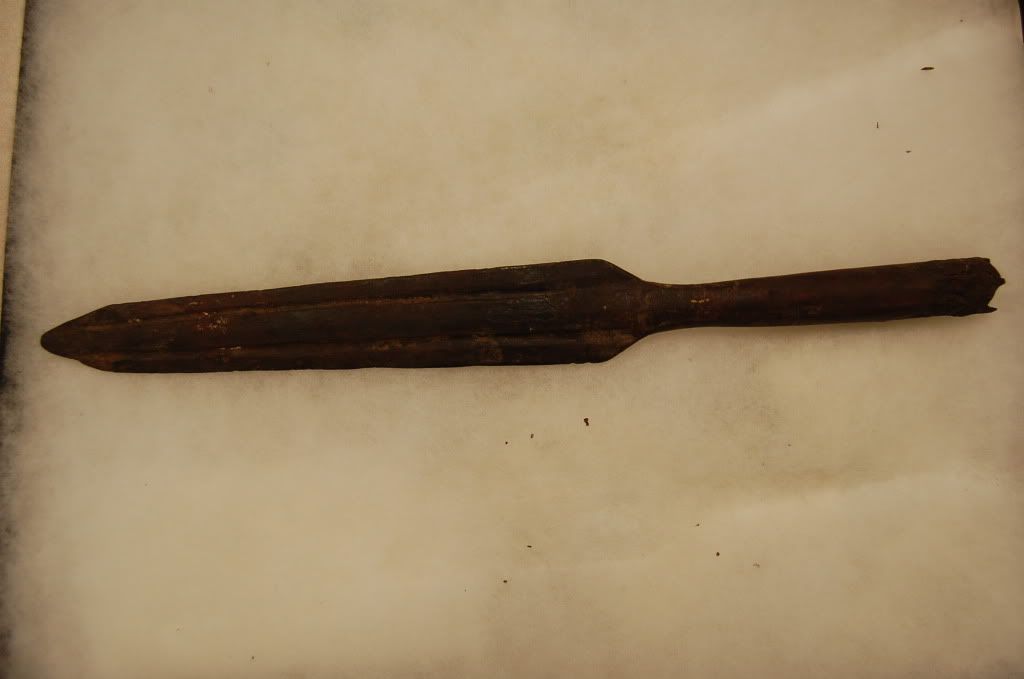
Next we have an older spear point that is Roman as well.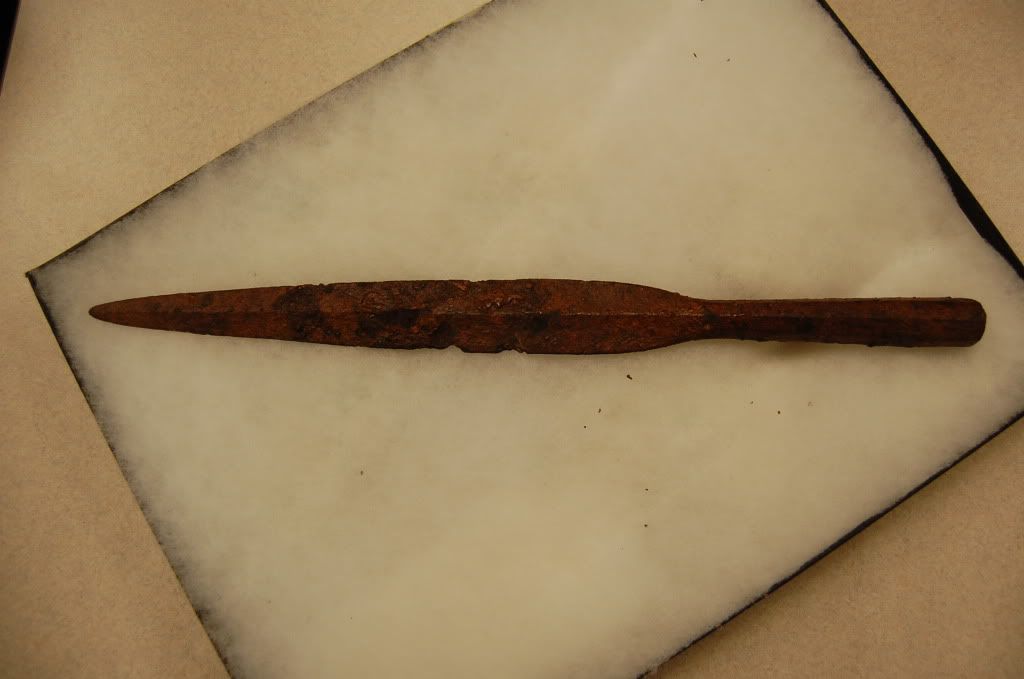
Following the Roman trend we have a camp axe head.
Another axe head (unsure of use. I didn't think to ask around with people more knowledgeable of Mediterranean/European artifacts, my specialty is Colonial America.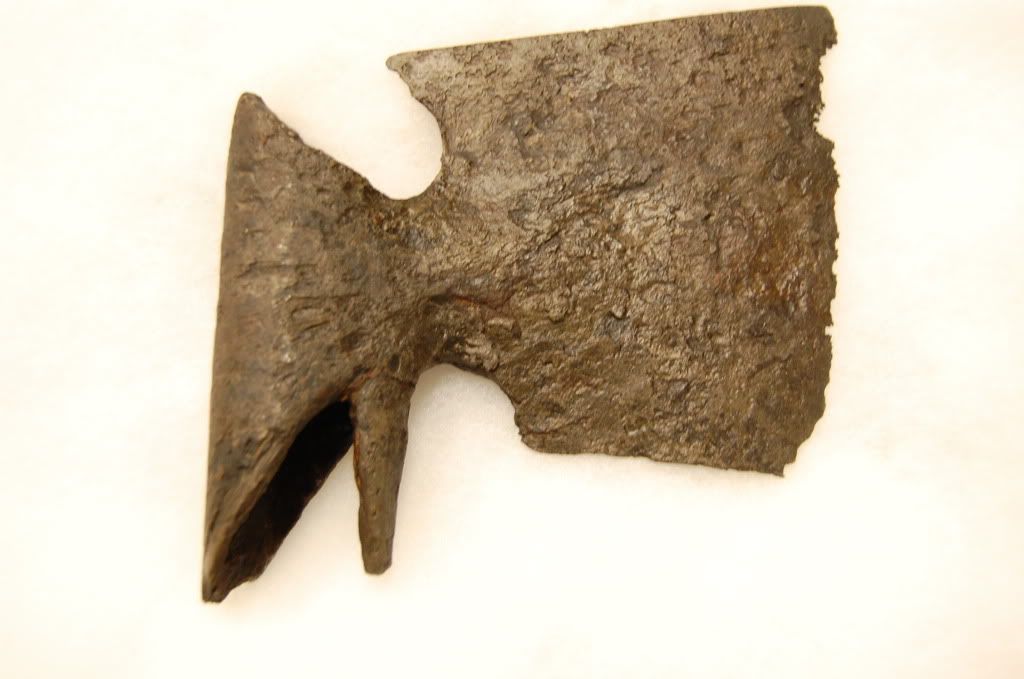
Two Roman arrow points of different designs, both forged. I had several others available that were much smaller and designed for the Visigoth chainmail, I can get pictures of those if anyone would want them.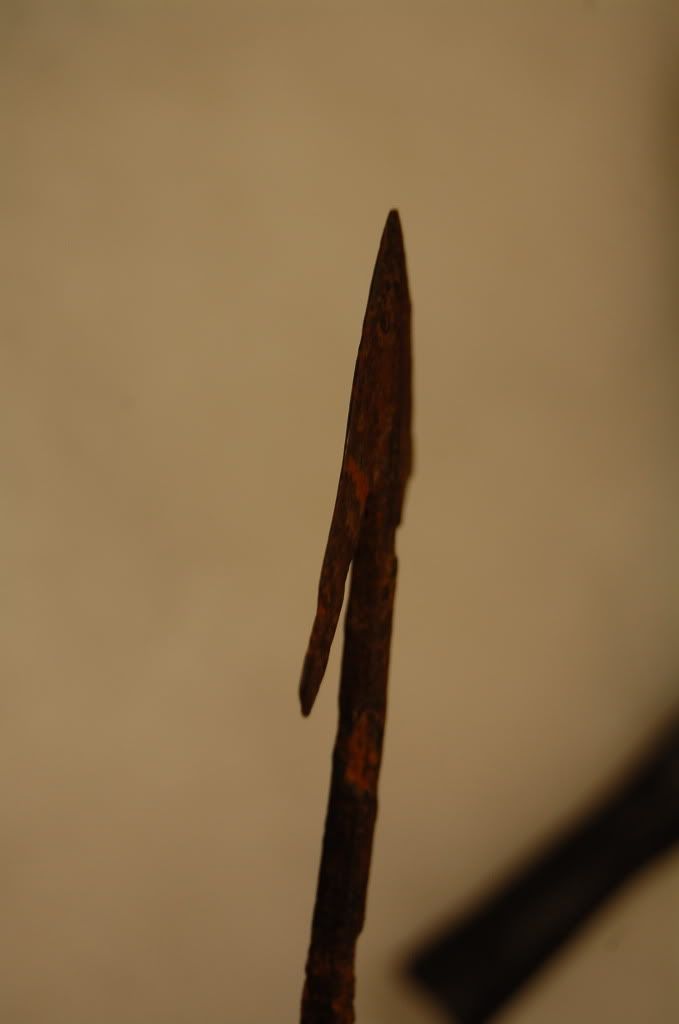
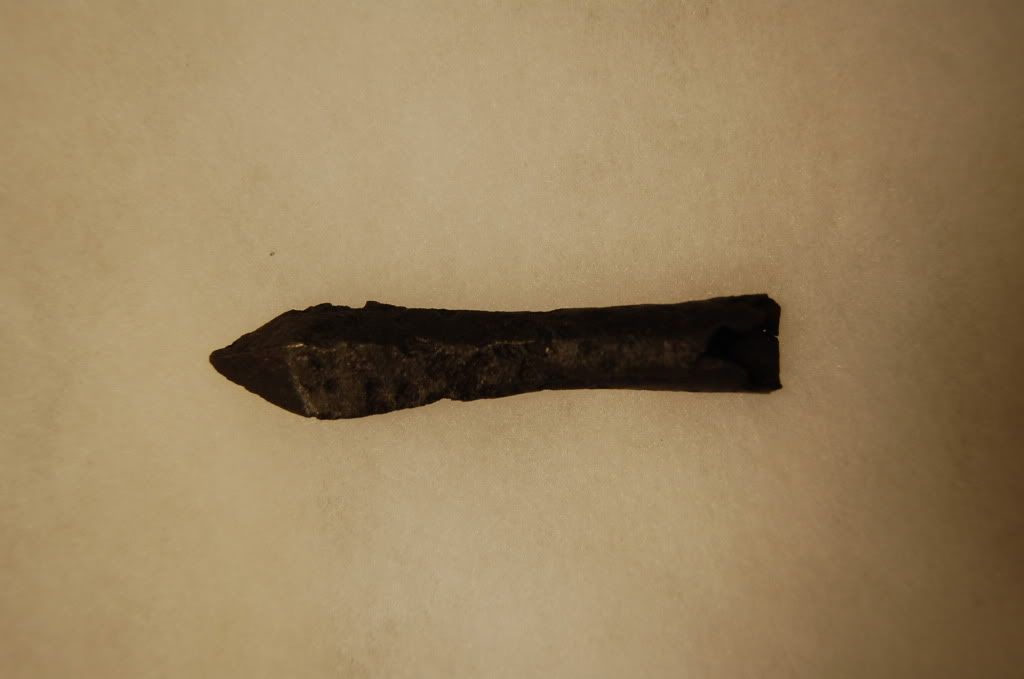
Three arrow points from Kiev, Ukraine. Medieval period (most accurate I could get) and possibly Viking.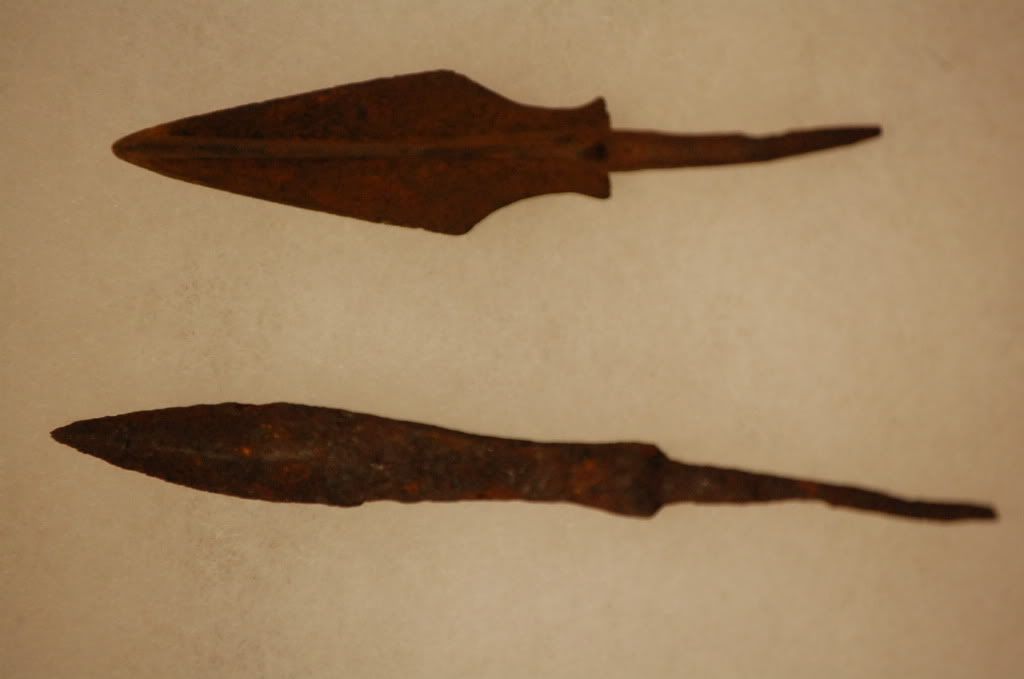
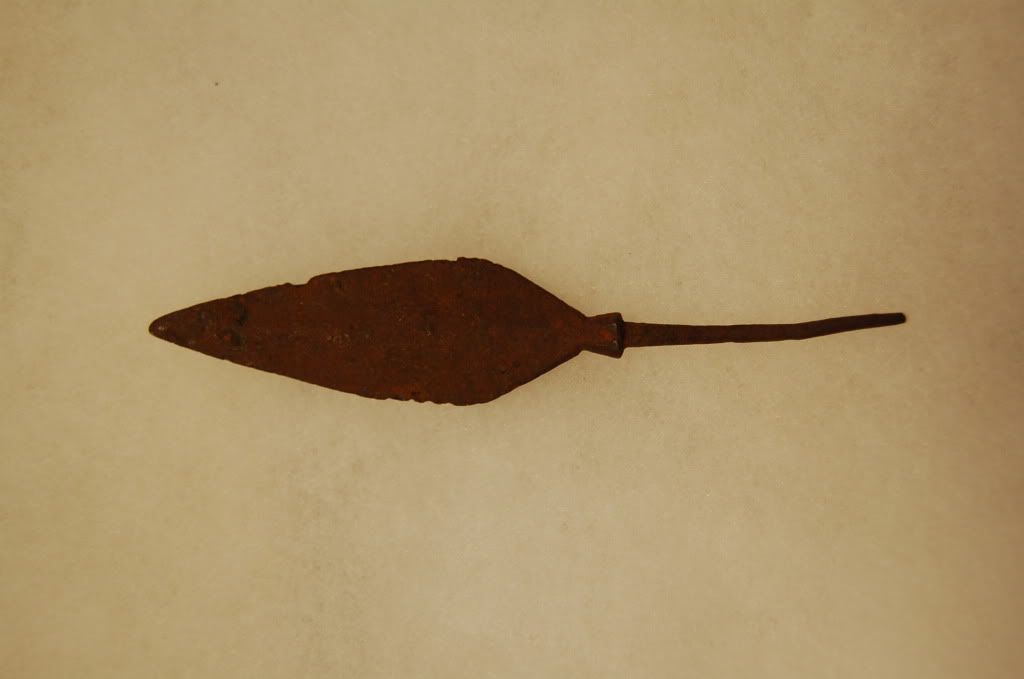
A Celtic axe from Gaul, contemporary with the Roman camp axe. Bronze.
All photos copywrite of my lovely girlfriend Ms. Shepherd. Credit where credit is due please.
Credit where credit is due please.
Permission has been provided by the copyright holder to use the photographs. Photo credit to Alison Shepherd. -
http://books.google.com/books?id=kbLmAAAAMAAJ&pg=RA1-PR28&img=1&zoom=3&hl=en&sig=ACfU3U3Hy1ev2jG39CJFGWyVfferUeIS3A&ci=23%2C16%2C892%2C1288&edge=0
I love old advertisements. :) -
-
Yes, I agree. I was worried that it would degenerate into sort of an anvil equivalent of bashing soccer moms for driving SUVs. "You don't need that Ford Excursion! You never haul more than Masie and Cindy to practice!"
And Jacob, I love me a good Excel file. I've got them for everything from converting acres and hectares to square feet, to steel block weights, to tire diameters from standard sizes.
I know people who are addicted to them. They do come in handy, that's for sure. -
This is fascinating. Thank you all.
I took maddog's formula and put it into Excel, adding variables for hammer and anvil weight, as well as changing the result from percent lost to overall percent efficiency. It made more sense to me to visualize the diminishing returns. I've attached it as a .zip file so people can see the numbers or play with them themselves.
Assuming a 2.5 lb hammer, reading comments from lots of people, and using the equation with a big grain of salt, I focused on the difference in efficiency between 250 and 400 pounds for an anvil. Just for the sake of argument, it seems like smiths can pretty readily tell the difference in forging between these two sizes.
2.5 lb hammer, efficiency:
250 lb anvil: 96.1%
400 lb anvil: 97.5%
Difference: 1.5%
So, again for the sake of argument, a good smith can easily tell a difference in efficiency of 1.5%, and there is a strong preference for being over 95% efficiency.
If we look at the numbers for a 5lb hammer,
5 lb hammer, efficiency:
250 lb anvil: 92.3%
400 lb anvil: 95.1%
Difference: 2.8%
And note that you don't hit that 95% (arbitrary) threshold until you're at 400 lb. Getting back to my original scenario that caused me to ask the question, I punched in a 10 lb hammer, like you might use with a striker.
10 lb hammer, efficiency:
250 lb anvil: 85.2%
400 lb anvil: 90.5%
Difference: 5.3%
To look at the effects of something the size of stewartthesmith's anvil and the 1000 lb Refflinghaus, we would be looking at:
10 lb hammer, efficiency:
750 lb anvil: 94.8%
1000 lb anvil: 96.1%
Given the fuzziness of this whole process, I'd call the 750 lb anvil close enough to the arbitrary 95%, but I also note that it's pretty close to the 1.5% that it seems can be readily noticed by smiths.
This also sheds some light on the engineering choices made by power hammer manufacturers. Somewhere around 20:1, it's cheaper to hit the material again than it is to design in a heavier anvil. When you're forging by hand, and the power isn't coming out of a electrical circuit, the calculus changes, and the ratio at which people seem to start to say "good enough" is 75:1 or 100:1
Very, very interesting.
Wonderful little Excel file. I'll be holding onto that.
I'll be holding onto that.
-
http://cgi.ebay.com/LOT-41-AMERICAN-BLACKSMITH-MAGAZINE-ANVIL-VISE-FORGE-/150525488500?pt=LH_DefaultDomain_0&hash=item230c04ad74#ht_11504wt_1139
Someone selling 41 complete issues scanned onto a CD. Sounds like a pretty nice little bundle. But... is it worth 20 dollars?
/ -
Interesting little trinket up for sale on ebay.
http://cgi.ebay.com/Peter-Wright-Anvils-Advertising-Print-Block-/150524679329?pt=LH_DefaultDomain_0&hash=item230bf854a1#ht_3390wt_905
Figured someone might find it neat enough to shell out 10 bucks for it. :) -
Sounds like you made the same mistake I made when I forged my first item. I was making a J-hook all pretty as you please when I burnt the curl and instead of a nice curl I have a rounded mass on the end. This is life, eh?
The thinner the material the easier it is to heat. The easier it is to heat, the easier it is to burnt. Keep a close eye on the tiny bits and you can avoid it (usually). Answering phones seems to induce burning as well. -
I've got access to some Roman or Greek fibulae. I'm not sure which they are but I'm comfortable with Roman right now, I want to say 4th century. I'll take some high definition photos of them for you guys to check out.
-
Nice shop. Just make short items so that you don't hit anything overhead. LOL. Hey, at least it gets you out of the weather.
Yeah. I'm going to close off the windows so that I can get some heat going from the forge. Feels like it's going to be a cold winter. -
Essentially I re-purposed an old playhouse we had on the property from when I was a kid. The ceiling is a bit low, and I have to look out for the propane lamp I'm using.. but hey! It's indoors and pretty cozy. Problem is, I have no forge as you might be able to see in the pictures.
 That's coming (soon).
That's coming (soon). -
My first knives that I made last weekend. I've only been at the forge once before I made these.
The first knife is made from a piece of lawnmower blade, the second from leaf spring.
I was mentored by a more experienced bladesmith from the forums here (RBrown) and I owe any success I have to him. Figured I'd throw them up to get some thoughts and suggestions for my next try.












First tongs... hooray
in Tongs
Posted
When the jaw broke I cut it off and started anew. Couldn't think of a way to do it other than that, with my skills.